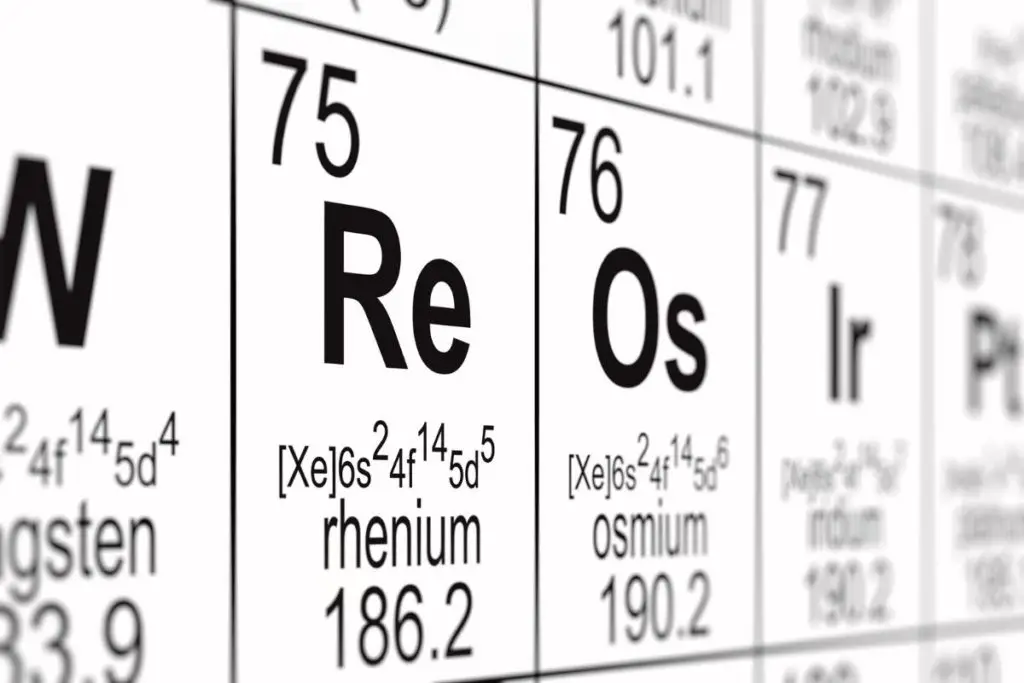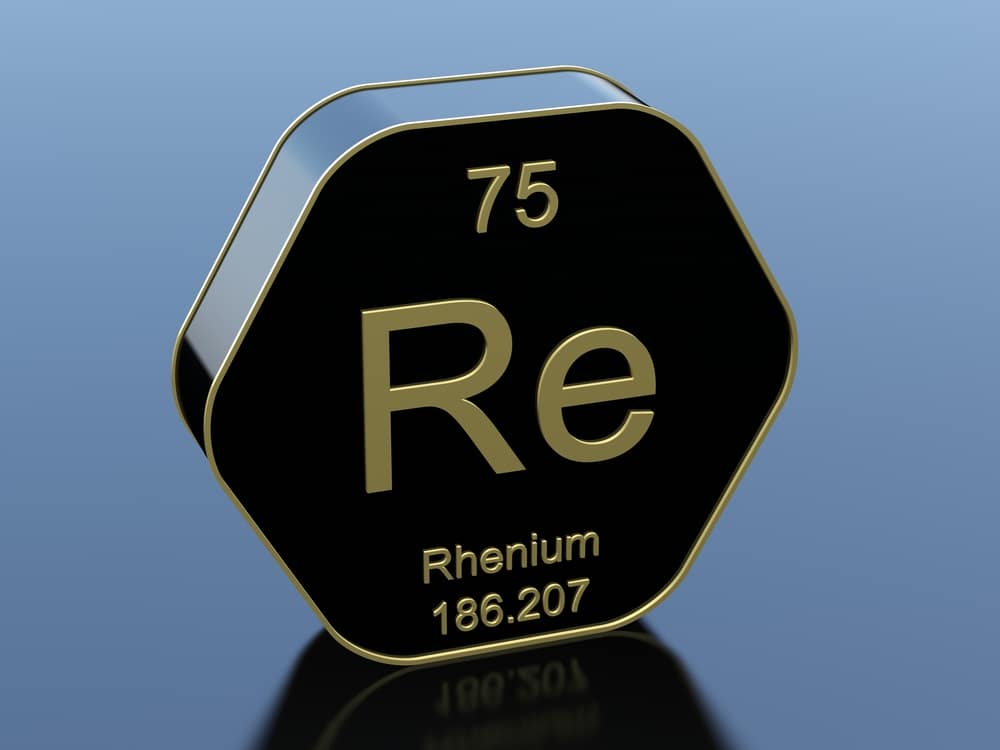Table of Contents
Rhenium is a precious metal found in the periodic table in the transitional metals group. This metal is a byproduct of refining molybdenum and copper ores. As an investment opportunity, rhenium is one of the top ten most expensive metals known, surpassing silver.
*This post may contain affiliate links. As an Amazon Associate we earn from qualifying purchases.
In this article we will discuss rhenium as an element, a byproduct and an investment. We will learn the rhenium history as well as they types of uses it has. Further, we will cover the investment opportunities and options as well as the pros and cons of investing in rhenium.
To see some options for buying pure rhenium just click here.
What Is Rhenium?
Rhenium is an element in the transitional metals grouping. It is the last discovered naturally occurring, stable element. Rhenium was found in Germany by Walter and Ida Noddack around 1925. Dimitri Mendeleev predicted the placement of the element in 1914 although it wouldn’t be discovered for more than a decade.
Rhenium is named for the Rhine River (Rhenus being Latin for Rhine) and is one of the rarest elements in the Earth with an estimated 1 part per billion. Of all the elements, rhenium element has the third highest melting point (behind only tungsten and carbon) as well as the fourth most dense (behind platinum, iridium and osmium).
Rhenium is found as a byproduct of refining copper ore as well as the more popular molybdenum. Extraction of the rhenium element has no known adverse side effects to the atmosphere.
Usually rhenium is powder but can be formed into a malleable solid with pressure or a hydrogen atmosphere. When condensed, the metal can be flattened, molded, coiled or bent. The most popular use is in the aerospace industry that relies on it’s extremely high melting and boiling points.
Is Rhenium Safe?
Rhenium has little to no known adverse side effects. However, that being said, there have been very little studies on the toxicity of rhenium. An isotopic solution delivered to rats showed levels of toxicity akin to table salt.
There are no known side effects to the Earth or the atmosphere and mining and extraction have not turned up any evidence to support there would be.

What is the Value of Rhenium?
Rarity and use, resulting in more demand than supply, greatly effect the rhenium price. The value of rhenium is generally given in pounds or kilograms instead of troy ounces. This gives an unusually high price point when comparing against other precious metals. When searching for current prices, make sure the comparison is of equal weight.
Rarity
Rhenium is one of the most rare elements in the Earth’s crust. While it is a naturally occurring element, it is found only as a byproduct of refining copper ore or molybdenum. The rarity drives the cost of production, mining and export or import go up rapidly. Luckily, there are copper and molybdenum deposits around the world.
Chile and the United States lead the global extraction of rhenium followed by countries that include Poland and Peru. It is estimated that 50 tons per year are produced. While it isn’t as rare as osmium (50 parts per trillion) it is much more easily extracted.
Since rhenium is malleable, it has garnered high usages for its melting and boiling points.
Uses of Rhenium
By far the most widely used application of rhenium is from the aerospace industries. Rhenium is used as a superalloy in jet engine parts due to the heat levels produced from these motors. Jet engine superalloy components account for over 70 percent of the worldwide usage of rhenium.
There are other aerospace applications for rhenium as well, however cheaper alternatives are constantly being studied. Because rhenium is so expensive, manufacturers are looking for different means to lower costs. If this happens the value of rhenium could see a dramatic decline.
While there have been some success in replacing rhenium, nothing major has yet to be used on a grand scale. This alone, because of the 70 percent usage, keeps rhenium vale and costs at a premium.
Rhenium isotopes are radioactive and are being used to treat liver cancer as well as pancreatic cancer, on an experimental level.
Anywhere there is a need for high heat resistance as well as malleable components, rhenium is used. This includes electronics, super conductors, electromagnets, crucibles and thermocouples.
Medicine and electronics account for another 20 percent of rhenium usage.
What is the Value of Rhenium?
Rhenium value, based on its rarity and usage in the aerospace industry keeps the price around an average of $1200 USD per pound or $2500 per kilogram. There is very slight fluctuation in the asking price which allows rhenium to be a stable investment option for struggling portfolios.
The threat of rhenium bottoming out is a real threat, however, since there are constant studies to replace rhenium in jet engine components. If rhenium is added to your portfolio, it will need to be followed closely.
Should You Invest in Rhenium?
Investing in rhenium is more risky than other precious metals. However there are benefits to adding rhenium to your portfolio. Any precious metal will add stability to a rocky portfolio and can be a catalyst for higher returns with lower risk.
Rhenium, unlike gold, silver or platinum, carries the risk of having very few applications. If the aerospace industry ever abandons their need for rhenium, there isn’t another industry ready to pick up the slack. As such, the risk of investing is higher than most other commonly traded metals.
Investing Options
As with most precious metals, there are several options for investment types and opportunities. The most common are physical investing and mining stock trading. Some other options aren’t available, such as EFTs even though the price and demand for rhenium support them.
Physical ownership is better than certificate trading. In the event of a crash, certificates hold no intrinsic value and cannot be exchanged for currency. However, physical ownership of rhenium bullion, ingots or coins also has its share of risks.
Theft or loss are virtually untraceable and recovering bullion or ingots is highly difficult. Not to mention the storage space required to have bars, ingots or coins. If you have a secure storage area, physical ownership is one of the safest options.
The downside to physical ownership is liquidation in the event the prices start to fall. If you are unable to liquefy the assets before the price bottoms out you may be at a severe loss.
The other, more promising, option is to invest in share holder stock for mining and production companies. These companies, unlike rhenium itself, are traded worldwide and around the clock. Buying and selling is cheaper and has more risk, but as long as supply is lower than demand, the stocks will continue to rise.
You have a lot of options for stock investment as a bulk of the production efforts are in North America
- Freeport McMoRan (NYSE: FCX); a mining operation in Arizona.
- Ivanhoe Mines (NYSE: IVN); large production miner of rhenium and copper.
- Jiangxi Copper Company (OTC: JIXAY); traded solely on the OTC market in New York.
- Rio Tinto (NYSE: RTP); a vast, on-going project based in Utah.
Other options worth noting include:
- Codelco
- CP Chemicals Group
- ESPI High Purity Metals
- Rhenium Alloys, Inc.
Where to Invest
If you plan to invest in mining or production companies the best option is to add the companies to your trade portfolio with the assistance of your stock broker. Since the mines and ore deposits are finite, company prices will rise and fall as they move around or have to shut down due to depletion.
Physical ownership can be done in person in some of the larger cities in North America such as New York and Las Angeles. It is more common, however, to acquire rhenium bullion, ingots or coins through online sales. You can find researchable databases for rhenium and other precious metals as well as websites devoted to the resale and purchase of rhenium ingots.
Pros Of Investing in Rhenium
- Precious metals stabilize a rocky portfolio.
- Demand for rhenium far exceeds supply at this moment.
- Long term forecasts have seen rhenium rise more than fall.
- Rarity keeps costs high.
Cons of Investing in Rhenium
- There is only one major source of demand for rhenium: aerospace.
- Rhenium is actively being replaced for cheaper options.
- Little to no fluctuation with a high starting price.
In Conclusion
Rhenium uses have a stranglehold on the supply and are constantly asking for more. However, those same demands are also trying to replace rhenium as the go-to material. If and when aerospace is able to switch rhenium for a cheaper option, rhenium prices will plummet.
While rhenium maintains its position as one of the top ten most expensive metals, the reliance on rhenium is underwhelming. If rhenium is added to your portfolio, it should be monitored closely.

